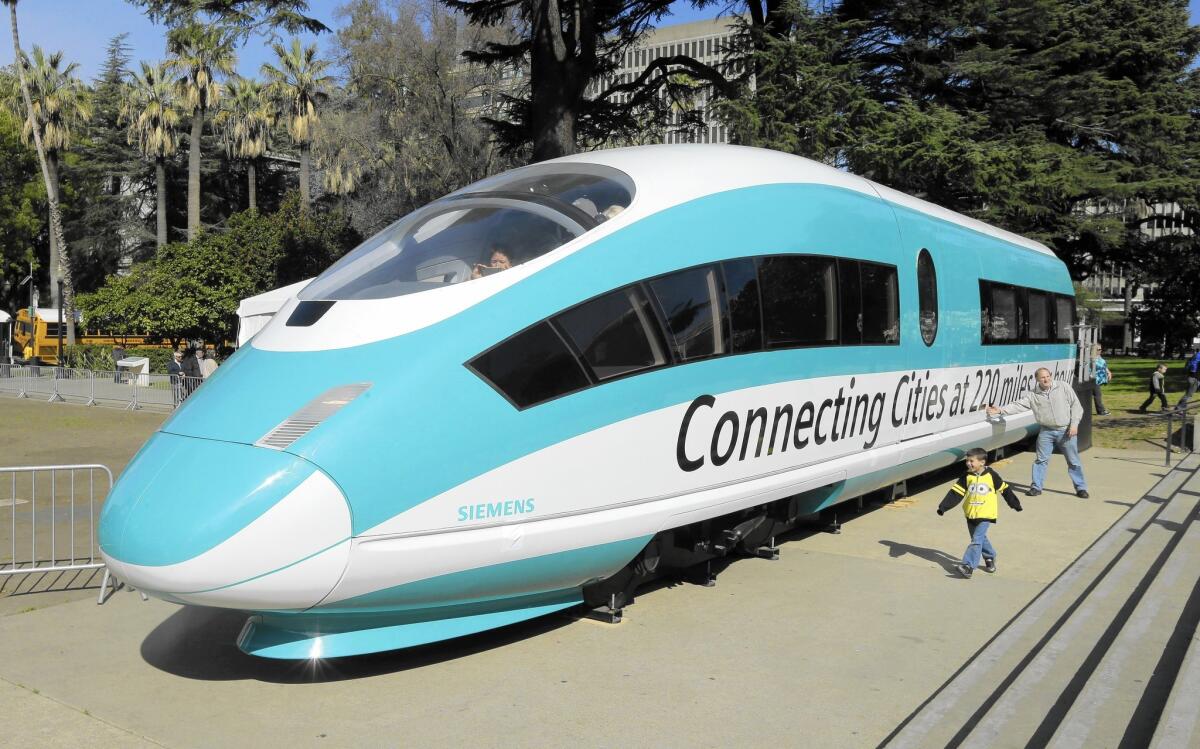What’s ahead for bullet train funding? Hearing outlines the many risks

- Share via
About half of the funding needed to build an initial operating segment of California’s bullet train faces legal, political and financial risks, state analysts told an Assembly hearing Monday — although officials expressed confidence that they could navigate any pitfalls.
The oversight hearing focused on a draft business plan released last month that proposed building the $21-billion section from San Jose to the Central Valley by tapping federal grants, state bonds and greenhouse gas fees. But questions loom over whether each portion of that funding could be guaranteed.
“We have to go into this with our eyes wide open,” said committee chairman Jim Frazier (D-Oakley). “Proceeding with this project will not be for the faint-hearted.”
Beyond the financial risks that could affect the initial segment, officials have not made clear where they would get the money needed to complete the system, estimated to be an additional $43.5 billion.
The state legislative analyst’s office and a peer review panel have said California should be clearer about how and when it will get those funds. At the hearing Monday, Hasan Ikhrata, executive director of the Southern California Assn. of Governments, agreed.
Though the committee members — including Frazier — largely expressed support for the project, the questions they asked during the three-hour hearing were more substantive and detailed than any legislative panel has raised in recent years.
And rail authority officials, including chairman Dan Richard, were more direct in laying out the project’s potential problems.
“There are going to be things that go wrong,” Richard said. “There are going to be things that are unexpected.”
But he rejected the assertions of critics who say the project has been compromised so drastically that it bears no resemblance to what voters approved in a $9-billion bond measure in 2008.
“We are delivering what the public voted for,” Richard said.
The dependence on cap-and-trade funding, which would supply about half the money for the initial segment, drew the most concern.
Frazier questioned whether the greenhouse gas marketplace would actually be shrinking over coming decades, while the rail authority’s planning is based on getting steady $500-million annual allotments.
The plan calls for issuing bonds against future revenues beyond 2025. But legislative analysts said that future was difficult to predict.
Depending on economic and technological trends, the number of greenhouse gas credits is expected to decrease over time, but the price of those credits could go up. Frazier asked whether private investors would buy bonds based on such uncertainty.
The answer from the expert peer review panel suggested California might face higher financing costs and probably would be forced to make outright guarantees to investors, difficult issues for a future legislature to consider.
The project does not need any immediate legislative action. It is moving along — constructing about 118 miles of track in the Central Valley — by virtue of its access to greenhouse gas fees and $3.2 billion in federal grants, as well as the voter-approved bonds.
But within a year or two, the Legislature will need to extend the fees beyond 2020 and authorize the rail authority to borrow against those future revenues. At the same time, the rail authority will have to figure out whether it can get past litigation that has tied up the bond funds for several years.
The new business plan also changed a previous commitment to build the initial segment from Burbank to the Central Valley. That prompted complaints Monday by representatives from both the Inland Empire and the Merced region.
Adam Gray, a Merced Democrat, said he had been blindsided by the decision that left Merced out of the initial segment.
“We owe you and your constituents an apology,” Richard said.
Assemblywoman Cheryl Brown (D-San Bernardino) wanted to know what good the project would do for her community, saying that the previous plan at least would have provided jobs in Southern California.
And Catharine Baker, a Bay Area Republican, asked Richard about a Los Angeles Times report Monday that said the lead contractor on the first 29 miles of construction through Fresno had submitted a list of more than 300 pending change orders that could add hundreds of millions of dollars to the project’s cost.
Richard said the state already had disclosed those risks to the public. “Could they result in cost increases? They could,” he said.
Twitter: @RVartabedian
Join the conversation on Facebook >>
ALSO
Will the $15 minimum wage pass California’s Legislature? And other key questions...
Former San Diego mayor was ‘creepy,’ but woman didn’t feel harassed, co-worker testifies
Yosemite’s granite cliffs are ‘breathing,’ and heat can make them fall
More to Read
Sign up for Essential California
The most important California stories and recommendations in your inbox every morning.
You may occasionally receive promotional content from the Los Angeles Times.











